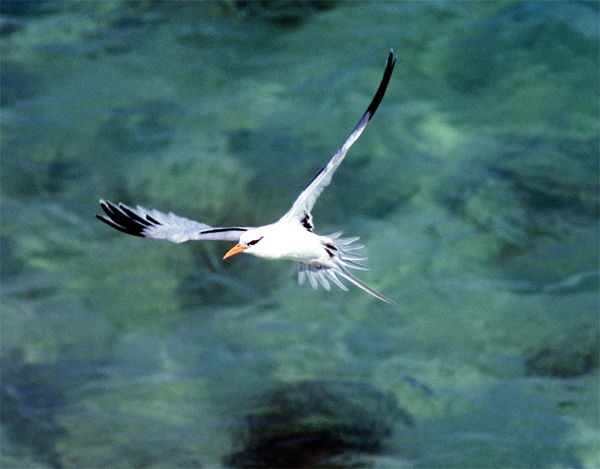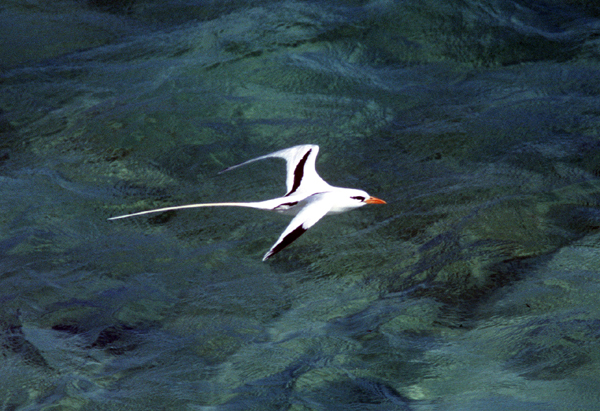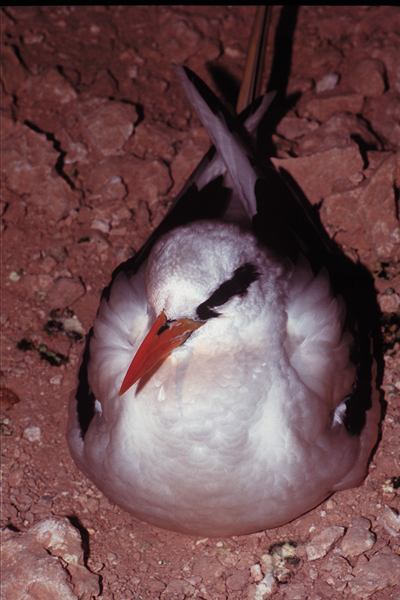| White-tailed Tropicbird
Phaethon lepturus Chirre,
|
 |
|
Photo: B. Hallett
|
|
IDENTIFICATION: A white, tern-like seabird with black wing tips and a black bar across the top of each wing. The two white, central tail feathers are narrow and very long. A black line extends through the eye. The bill is yellow, orange or reddish-orange. Immature birds have a barred back, but lack the adultís long tail. Length: 70-82 cm. (mostly the long tail streamer); weight: 220-410 g. VOICE: The voice is a single or double, raspy "kik." HABITAT: Nests on isolated rocky cliffs, but spends much of its life far out at sea. HABITS: The White-tailed Tropicbird flies with rapid, deep wing beats high over the ocean, but will hover like an apparition over a fishing boat, unnoticed by human mariners until someone happens to look straight overhead. One theory is that the tropicbird has learned to home in on boats to catch flying fish that boats might flush. As the tropicbird flies, its long tail waves in a series of graceful curves. When it lands at sea in calm conditions, it holds its two central tail feathers high in an arc. The tropicbird travels alone over great distances to feed in patches of warm sea water. It feeds on squid and small fish---especially flying fish (Exocoetidae)---by diving from high above the sea surface. Air sacs in the birdís upper body cushion the impact with the water. Fish species from 14 families of fish have been identified as tropicbird prey in Puerto Rico. Its nest is on a bare ledge or in a crevice on a rocky cliff or talus slope. Between January and June the female lays a single white or pinkish egg with brown spots. The tropicbirdsí legs are so short, that it has to push its body with legs and wings to move on land. Because this species feeds far at sea, each parent may incubate for 7-9 days straight before being relieved by the other parent. The adult may lose 20% of its body weight during each incubation shift. The incubation period is long---about 41 days---and chicks donít fledge until 71-73 days after hatching. STATUS AND CONSERVATION: A locally common species in late winter and spring near its nesting cliffs. Formerly hunted for food by Native Americans in the Caribbean, and later was hunted commercially for its feathers. Rats and crabs take a toll of young and eggs at some nesting islands, and oil pollution is a threat. The population in Puerto Rico has declined dramatically in the last few centuries. It formerly nested on cliffs of the southwestern and northern coasts of the main island of Puerto Rico, but is now restricted there to the northwestern coast and Mona, Monito, Culebra, and Caja de Muertos Islands. Only about 2,500-3,500 pairs nest throughout the West Indies. RANGE: Found in tropical seas around the world. A regular location to see this species from the main island is the northwestern cliffs between Isabela and Barceloneta, especially at Guajataca. It is uncommon east of Puerto Rico. TAXONOMY: PELECANIFORMES; PHAETHONTIDAE |
|
 |
|
|
Photo: B. Hallett
|

